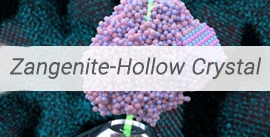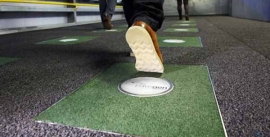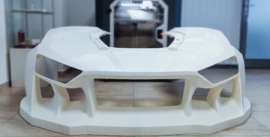 جدید
جدیدآلیاژ جدید،تحت کرنش،رازهایی را برملا می کند!
آلیاژ جدید،تحت کرنش،رازهایی را برملا می کند!
[box type=”shadow” align=”alignright” ]
گروهی از پژوهشگران به سرپرستی دانشمندانی از آزمایشگاه ملی لارنس برکلی وابسته به وزارت انرژی ایالات متحده، متوجه مکانیزمهای متعددی شدهاند که باعث ایجاد یک ماده جدید سرمادوست و یکی از چقرمهترین آلیاژهای فلزی تا کنون شده است.
برای دانستن رازهای این ماده این گروه تحقیقاتی، آلیاژ را با میکروسکوپ الکترونی عبوری (TEM) در هنگام اعمال کرنش به ماده مطالعه نمودند. تصاویر نشان داد که چندین مکانیزم در مقیاس نانو، یکی پس از دیگری در آلیاژ فعال می شوند که همراه با هم در مقابل گسترش آسیب مقاومت میکنند. در میان این مکانیزم ها، پله ایی هستند که در عرض ترکها برای جوگیری از انتشار آنها تشکیل می شوند. این پل سازی روی ترک، یک مکانیزم مرسوم چقرمه سازی در کامپوزیتها و سرامیک هاست اما غالبا در فلزات تقویت نشده، دیده نمی شود.
یافته های آنها میتواند پژوهش های آینده را به سمت طراحی موادی فلزی با تلرانس آسیب نامنطبق هدایت نماید. این پژوهش در نشریه Nature Communications موجود است.
در علم مواد، چقرمگی، مقاومت یک ماده را در برابر شکست توصیف میکند در حالی که استحکام، مقاومت یک ماده در برابر تغییرشکل است. اینکه یک ماده هم بسیار چقرمه باشد و هم مستحکم بسیار نادر است اما CrMnFeCoNi یک آلیاژ عادی نیست. این آلیاژ یک ستاره در میان کلاس جدید آلیاژهای توسعه یافته در حدود یک دهه قبل است که دارای 5 عنصر یا بیشتر با مقدارهای تقریبا برابر است. در مقابل، بیشتر آلیاژهای معمولی یک عنصر غالب دارند. این آلیاژهای چندجزئی جدید آلیازهای با آنتروپی بالا نامیده میشوند زیرا عمدتا از یک فاز محلول جامد ساده تشکیل میشوند و بنابراین آنتروپی اختلاط بالایی دارند.
آلیاژهای با آنتروپی بالا موصوعی داغ در پژوهش مواد هستند اما تنها به تازگی به مقدار مناسبی پژوهش درباره انها انجام شده است. در 2014، ریچی و همکارانش دریافتند که در دماهای بسیار کم، هنگامی CrMnFeCoNi که تغییرشکل می دهد، پدیدهای بنام دوقلویی رخ میدهد که در آن مناطق بلوری همسایه، آرایشی آینه ای نسبت به یکدیگر تشکیل می دهند. دوقلویی احتمالا در چقرمگی و استحکام شگفت انگیز آلیاژ نقش ایفا میکند. اما دوقلویی بطور گستردهای در این آلیاژ در دمای اتاق یافته نمی شود (بهجز در پلهای روی ترک) در حالی که چقرمگی و استحکام آلیاژ همچنان، تقریبا بسیار بالا است.
ریچی میپرسد: اگر ما دوقلویی را در دمای اتاق نمیبینیم پس چه مکانیزمهای دیگری باعث این خواص شگفت انگیز در آلیاژ میشوند؟ برای یافتن پاسخ، دانشمندان آلیاژ را در معرض آزمایشهای کرنشگذاری متعددی در دمای اتاق قرار دادند و از TEM برای مشاهده اتفاقات استفاده کردند.
تصویربرداری در مرور زمان، دو پدیده مربوط به تنش برشی را نشان دادند: حرکت آهسته نابجاییهای کامل که باعث استحکام ماده میشوند و حرکت سریع نابجاییهای جزئی که داکتیلیته را بهبود م یدهند. انها همچنین پدیدهای درباره نابجاییهای جزئی با عنوان ” عیوب نقص چیدمان سه بعدی” مشاهده نمودند که شامل تغییراتی در آرایش سه بعدی اتم ها در آلیاژ می شود. این نقایص مانند قرار دادن یک تودهای آجر در برابر یک شکاف در حال رشد، مانع بزرگی برای نابجایی ها هستند و آلیاژ را سخت می کنند.
تصاویر همچنین نسخه نانومقیاسی از جویدن یک تافی دهانپرکن که باعث جسبیدن دندانها به یکدیگر میشود، بدست آوردند: در برخی موارد، پلهای کوچک تغییرشکل یافته توسط دوقلویی در عرض یک ترک ایجاد می شوند که به جلوگیری از پهنتر شدن ترک کمک می کنند. ریچی میگوید: این پلها در سرامیکها و کامپوزیت های تقویتشده مرسوم هستند. پژوهش ما نشان داد که همه این مکانیزم ها در مقیاس نانو با هم عمل میکنند تا باعث چقرمگی و استحکام آلیاژ شوند.
[box type=”info” align=”alignright” width=”1124″ ]منبع : newscenter.lbl.gov
ترجمه : محسن حاجی زمانی [/box]
[divider]
New alloy reveals secrets when put under strain
A team of researchers led by scientists from the US Department of Energy’s Lawrence Berkeley National Laboratory (Berkeley Lab) has identified several mechanisms that make a new, cold-loving material one of the toughest metallic alloys ever.
The alloy is made of chromium, manganese, iron, cobalt and nickel, so scientists refer to it as CrMnFeCoNi. It’s exceptionally tough and strong at room temperature, which translates into excellent ductility, tensile strength and resistance to fracture. And unlike most materials, the alloy becomes tougher and stronger the colder it gets, making it an intriguing possibility for use in cryogenic applications such as storage tanks for liquefied natural gas.
To learn its secrets, the Berkeley Lab-led team studied the alloy with transmission electron microscopy (TEM) as it was subjected to strain. The images revealed several nanoscale mechanisms that activate in the alloy, one after another, which together resist the spread of damage. Among the mechanisms are bridges that form across cracks to inhibit their propagation. Such crack bridging is a common toughening mechanism in composites and ceramics but is not often seen in unreinforced metals.
Their findings could guide future research aimed at designing metallic materials with unmatched damage tolerance. The research appears in a paper in Nature Communications.
“We analyzed the alloy in earlier work and found spectacular properties: high toughness and strength, which are usually mutually exclusive in a material,” says Robert Ritchie, a scientist with Berkeley Lab’s Materials Sciences Division who led the research with Qian Yu of China’s Zhejiang University and several other scientists. “So in this research, we used TEM to study the alloy at the nanoscale to see what’s going on.”
In materials science, toughness describes a material’s resistance to fracture, while strength describes a material’s resistance to deformation. It’s very rare for a material to be both highly tough and strong, but CrMnFeCoNi isn’t a run-of-the-mill alloy. It’s a star member of a new class of alloys developed about a decade ago that contains five or more elements in roughly equal amounts. In contrast, most conventional alloys have one dominant element. These new multi-component alloys are called high-entropy alloys because they consist primarily of a simple solid solution phase, and therefore have a high entropy of mixing.
High-entropy alloys are a hot topic in materials research, but have only recently been available in a suitable quality for study. In 2014, Ritchie and colleagues found that at very cold temperatures, when CrMnFeCoNi deforms, a phenomenon called ‘twinning’ occurs, in which adjacent crystalline regions form mirror arrangements of one another. Twinning likely plays a part in the alloy’s incredible toughness and strength. But twinning isn’t extensively found in the alloy at room temperature (except in the crack bridges), yet the alloy’s toughness and strength is still almost off the charts.
“If we don’t see twinning at room temperature, then what other mechanisms give the alloy these amazing properties?” asks Ritchie. To find out, the scientists subjected the alloy to several straining experiments at room temperature, and used TEM to observe what happens.
Their time-lapse images revealed two phenomena related to shear stress: slow-moving perfect dislocations that give the material strength, and fast-moving partial dislocations that enhance ductility. They also saw a phenomenon involving partial dislocations known as ‘three-dimensional stacking fault defects’, which involves changes to the three dimensional arrangement of atoms in the alloy. These faults are big barriers to dislocation, like placing a stack of bricks in front of a growing fissure, and serve to harden the alloy.
The images also captured the nanoscale version of chewing a mouthful of toffee and having your teeth stick together: in some cases, tiny bridges deformed by twinning are generated across a crack, which help prevent the crack from growing wider. “These bridges are common in reinforced ceramics and composites,” says Ritchie. “Our research found that all of these nanoscale mechanisms work together to give the alloy its toughness and strength.”
This story is adapted from material from the Lawrence Berkeley National Laboratory, with editorial changes made by Materials Today. The views expressed in this article do not necessarily represent those of Elsevier. Link to original source.










دیدگاه کاربران